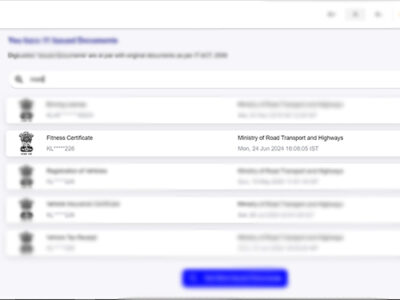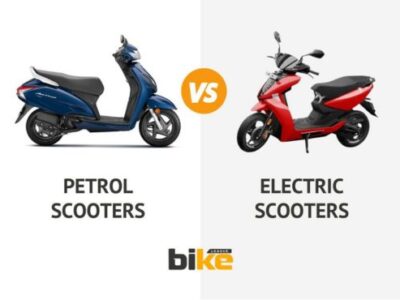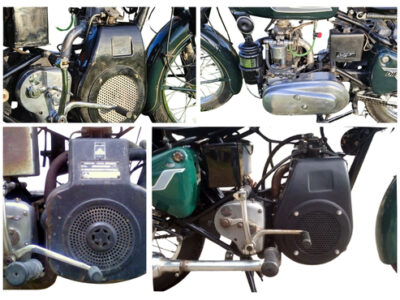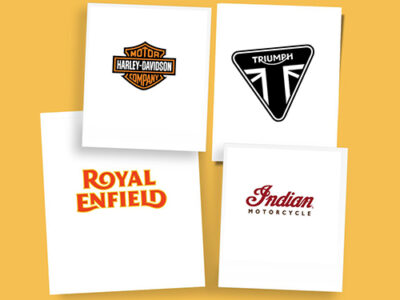
|
Getting your Trinity Audio player ready...
|
Long story short: Learn about the causes of road motorcycle accidents in India, statistics, including fatality rates. Explore solutions for safer roads for bikes and riding practices.
Motorcycles and scooters have become the heartbeat of India, effortlessly weaving through the dynamic fabric of urban and rural landscapes. Their cost-effectiveness and agility make them the ultimate choice for zipping through crowded city streets and embarking on adventures down picturesque country roads.
Yet, amidst this thrilling rise in two-wheeled popularity lies a stark and urgent reality—India faces an alarming wave of road accidents involving motorcycles and scooters. This article profoundly explores the shocking statistics and common causes of road motorcycle accidents from 2017 to 2022 and uncovers the pressing need for action.
Motorcycle Accident Statistics in India (2017-2022)
Below is a table summarising data on motorcycle accidents and fatalities in India:
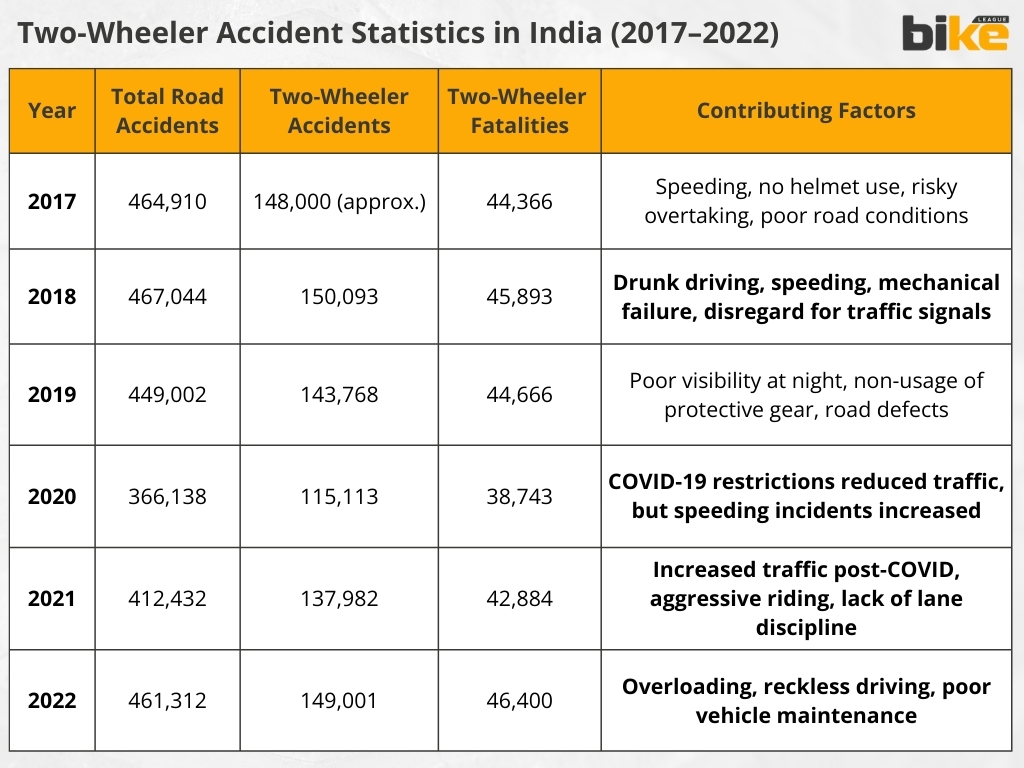
Detailed analysis of what are the causes of road Motorcycle Accidents in India
Motorcycle accidents continue to be a pressing issue in India, affecting countless lives each year. Let’s dive into the primary causes of road Motorcycle Accidents in India, revealing the underlying factors contributing to road safety concerns.
1. Speeding
Percentage of cases: 37%
Speeding remains one of the top causes of motorcycle accidents. High-performance bikes and scooters, such as the KTM Duke 200/390 and Yamaha R15, often lead to loss of control, particularly in urban and semi-urban areas.
2. Helmet Non-Compliance
Impact on fatalities: 25%
Many riders and pillion passengers neglect helmet use despite mandatory laws, significantly increasing the risk of head injuries. This one takes second place in causes of motorcycle accidents in India.
3. Alcohol and Drug Influence
Fatality contribution: 15%
Riding under the influence of alcohol or drugs impairs judgment and reaction time, leading to severe collisions.
4. Poor Road Infrastructure
Involvement in accidents: 12%
Potholes, inadequate signage, and poorly lit roads exacerbate the likelihood of accidents, especially in rural areas.
5. Mechanical Failures
Percentage of cases: 8%
Poor maintenance, including worn-out brakes and tyre blowouts, directly contributes to accidents.
6. Weather Conditions
Accidents during adverse weather: 6%
Rain and fog reduce visibility and traction, making two-wheelers highly vulnerable. To mitigate these risks, ride at a reduced speed, maintain a safe distance from other vehicles, and ensure your bike’s brakes and tyres are in good condition.
7. Distracted Riding
Contributing factor: 5%
Usage of mobile phones or other distractions has become a growing issue, especially in urban areas.

By understanding these causes, we can take proactive steps toward safer riding practices and ultimately reduce the causes of motorcycle accidents in India.
Some of the common motorcycle models involved in accidents in India
1. Commuter Motorcycles (100cc–150cc)
Popular Models
- Hero Splendor
- Honda Shine
- Bajaj Pulsar 150
- TVS Apache RTR
Commuter motorcycles are a staple on Indian roads, but they come with their own set of challenges. With a substantial 45% of motorcycle accidents in India linked to this category, it’s crucial to understand why.
Key Accident Factors
- Lack of Protective Gear: Many riders neglect helmets, significantly increasing the risk of injury.
- Speeding: Riders often push the limits even with smaller engines.
- Unsafe Overtaking: The hustle of urban traffic can lead to dangerous decisions.
2. Performance Motorcycles (150cc–300cc)
Popular Models
- KTM Duke 200/390
- Royal Enfield Classic 350
- Yamaha R15
For thrill-seekers drawn to the power of performance motorcycles, caution is key. This segment makes up around 20% of motorcycle accidents in India, particularly involving high-speed incidents.
Key Accident Factors
- Over-Speeding: The allure of speed can lead to reckless behaviour.
- Rider Inexperience: Not all riders are prepared for these machines’ power.
- Reckless Driving: Stunts and thrill-seeking can put riders and others in harm’s way.
3. Scooters (Electric and IC Engine)
Popular Models
- Honda Activa
- TVS Jupiter
- Bajaj Chetak Electric
Scooters are a common choice for commuters, especially in bustling urban environments. Yet, they contribute to approximately 25% of motorcycle accidents in India.
Key Accident Factors
- Braking Limitations: Many scooters lack advanced braking systems, making stopping challenging.
- Stability Issues: At higher speeds, scooters can become unstable.
- Road Awareness: Young riders often lack awareness of their surroundings.
4. Luxury and Touring Motorcycles
Popular Models
- Harley-Davidson Street 750
- Triumph Bonneville
- Kawasaki Ninja
Though a smaller market segment, luxury and touring motorcycles can lead to some of the most severe accidents, accounting for about 5% of motorcycle accidents in India.
Key Motorcycle Accident Factors
- Highway Over-Speeding: Riders often exceed safe limits on long stretches.
- Inadequate Training: Many don’t receive the proper training to handle these heavy bikes.
- Fatigue: Long-distance travel can wear down even experienced riders.
What are the most common situations for motorcycle accidents in India?
Let’s explore the most frequent scenarios where motorcycle accidents occur in India, along with their underlying causes and relevant statistics:
1. Left-Hand Turn Accidents
Left-hand turn accidents account for more than 50% of motorcycle accidents in India. These typically occur when a vehicle turns left at an intersection, colliding with an oncoming motorcycle. The primary reasons for these accidents include:
- Poor visibility of motorcycles to other drivers
- Misjudgment of motorcycle speed by turning vehicles
- Failure to yield the right of way to motorcyclists
2. Rear-End Collisions
Rear-end collisions are another common type of motorcycle accident, often occurring in heavy traffic or when vehicles fail to notice motorcycles slowing down or stopping. Contributing factors include:
- Tailgating
- Distracted driving
- Sudden braking by motorcyclists
3. High-Speed Collisions
Speeding significantly contributes to motorcycle accidents in India. High-speed collisions often result in severe injuries or fatalities due to the lack of protection for riders. In 2022, 28% of motorcycle riders involved in fatal crashes were impaired by alcohol, highlighting the dangerous combination of speeding and substance use.
4. Lane-Switching Accidents
Lane-switching accidents are prevalent in India’s congested urban areas. These occur when motorcyclists change lanes or other vehicles unexpectedly enter a motorcycle’s lane. The practice of ‘lane-splitting ‘, where motorcycles move between slow-moving or stopped traffic lanes, exacerbates this issue. Lane-splitting can be dangerous as it increases the risk of a collision with other vehicles, especially if they are not expecting a motorcycle to be in between lanes.
5. Accidents on Wet or Slippery Roads
Environmental factors play a significant role in motorcycle accidents. Wet or slippery road conditions, especially during monsoon seasons, increase the risk of skidding and losing control. This is particularly dangerous for motorcycles due to their inherent instability compared to four-wheeled vehicles. Riders should reduce their speed, avoid sudden manoeuvres, and ensure their tyres have good tread depth for better grip on wet roads to mitigate these risks.
6. Collisions with Heavy Vehicles
Collisions between motorcycles and heavy vehicles like trucks are common on national highways. These accidents often result in fatalities due to the size and speed disparity between motorcycles and larger vehicles.
7. Accidents Due to Road Infrastructure Issues
Poor road infrastructure contributes significantly to motorcycle accidents in India. Potholes, inadequate lighting, and poor signage create hazardous conditions for riders. The lack of dedicated lanes for different vehicle types further compounds the problem, leading to mixed traffic conditions that increase accident risks.
8. Demographic Insights and Risk Factors
Understanding the demographics most affected by motorcycle accidents is crucial for developing targeted safety interventions. A study focusing on motorcycle fatalities in South Delhi revealed that the most common age group involved in these accidents was 21-30 years, with males being disproportionately affected (93.6% of victims). Young riders, mainly those aged 18 to 25, are more susceptible to road crashes due to inexperience and age-related risk-taking behaviours. This demographic is more likely to engage in risky behaviours such as:
- Speeding
- Performing stunts
- Violating traffic rules
- Riding under the influence of alcohol or drugs
What are the contributing factors to road Motorcycle Accidents in India?
Motorcycle accidents in India are a significant concern, influenced by human behaviours, road conditions, and vehicle issues. Let’s dive deeper into the factors that heighten the risk of these accidents.
1. Human Factors
- Risky Behaviors: Young male riders often push the limits with reckless riding habits, making risky choices on the road.
- Alcohol and Drug Use: Recent statistics show that motorcycle riders were more likely to be found under the influence in fatal crashes compared to drivers of other vehicle types in 2022.
- Distraction: The growing trend of using mobile phones while riding poses a serious threat, as it distracts riders and compromises their reaction times.
- Helmet Non-Use: A staggering number of riders skip wearing helmets, which drastically increases the likelihood of severe injuries or fatalities in case of an accident.
2. Road Conditions
- Poor Infrastructure: Neglected roads riddled with potholes and insufficient lighting pose dangers that can easily lead to accidents.
- Traffic Density: The chaotic mix of vehicles on the road, particularly in bustling urban areas, escalates the chances of collisions.
3. Two-wheeler Issues
- Poor Maintenance: Many young riders rely on second-hand motorcycles that often suffer from a lack of proper upkeep, increasing the risk of mechanical failures.
- Lack of Safety Features: Unfortunately, a significant number of motorcycles in India lack basic safety features like anti-lock braking systems (ABS), which could make a real difference in preventing accidents or lessening injuries.
Understanding these factors is crucial in addressing and reducing the alarming rate of motorcycle accidents. Awareness, education, and better infrastructure can pave the way for safer rides on Indian roads.
What initiatives are the government taking to improve road safety for two-wheeler users in India?
First, let us understand the key Government bodies responsible for road safety in India.
Key Government Bodies Responsible for Road Safety
Several government bodies are involved in road safety initiatives in India:
1. Ministry of Road Transport and Highways (MoRTH)
This is the apex body responsible for formulating and administering rules, regulations, and laws related to road transport in India. It is crucial in setting national road safety standards and promoting a road safety culture.
2. National Highways Authority of India (NHAI)
An autonomous agency under MoRTH, NHAI is responsible for developing, maintaining, and managing National Highways, ensuring they are constructed and maintained to high safety standards.
3. Central Road Research Institute (CRRI)
This autonomous body under MoRTH conducts research and provides technical support for road safety and infrastructure development.
4. National Road Safety Council (NRSC)
Chaired by the Minister of MoRTH, the NRSC is an apex body that takes policy decisions regarding road safety and coordinates with various stakeholders to implement road safety measures nationwide.
5. State Transport Departments
Each state’s transport department implements road safety measures per the Motor Vehicles Act 1988.
6. National Road Safety Board
Constituted in 2021, this board plays a crucial role in formulating policies and strategies for road safety.
Recent and Ongoing Government Initiatives
The Indian government has implemented several initiatives to enhance two-wheeler safety:
1. Legislative Measures
Several legislative measures have been implemented or proposed to enhance two-wheeler safety.
Motor Vehicle Amendment Act, 2019
This amendment introduced stringent penalties for traffic violations, aiming to enforce road safety regulations more strictly.
Mandatory Safety Features
- Automatic Headlight On (AHO): Since April 2017, all new motorcycles in India must have headlights that switch automatically when the ignition is turned on.
- Anti-Lock Braking System (ABS) and Synchronised Braking System (SBS): As of April 1, 2019, ABS is mandatory for all two-wheelers above 125 cc, while SBS is required for those under 125 cc.
Helmet Regulations
The government has mandated that all helmets sold in India must comply with compulsory quality control certifications (BSI & ISI).
Increased Fines and Penalties
The Motor Vehicle Act amendment included increased fines for violations such as riding without a helmet, speeding, and other traffic infractions.
2. Infrastructure Improvements
A range of infrastructure improvements is being implemented to enhance the safety of two-wheeler riders on our roads:
Dedicated Two-Wheeler Lanes
Exclusive two-wheeler lanes are being created on state highways and city roads to separate them from other vehicles, significantly reducing accident risks.
Advanced Stop Boxes
Inspired by Taipei, advanced stop boxes will be introduced at intersections, allowing two-wheelers to stop ahead of other vehicles for increased visibility and safety.
Pedestrian Bridges and Underpasses
New pedestrian bridges and underpasses are being constructed to separate foot and bike traffic from vehicles, helping to reduce accidents.
Mandatory Road Safety Audits
Road safety audits will now be mandatory on state highways and urban roads to identify and fix hazardous areas for two-wheelers.
Integrated Road Accident Database (IRAD)
The Integrated Road Accident Database will track accidents to effectively identify and address dangerous locations.
Speed Management Devices
Speed management devices will be installed on urban roads and highways to enforce speed limits and enhance overall safety for all road users.
These initiatives promise a safer environment for two-wheeler riders and other road users.
3. Awareness and Education Campaigns
Public awareness campaigns
have been launched to promote road safety among two-wheeler riders. These initiatives aim to change public attitudes towards safety regulations and encourage the use of protective gear.
Road Safety in School Curriculum
The government has proposed including road safety education in school curriculums and organising annual road safety workshops. This proactive approach targets youth, who constitute over 50% of road fatality victims, aiming to instil safe driving habits from an early age.
4. Enforcement Strategies
Several enforcement strategies have been implemented:
- Increased Fines and Penalties: The 2019 Motor Vehicle Act amendment significantly increased traffic violation fines.
- Use of Technology: Some cities have implemented e-challan systems and over-speed violation detection cameras to enhance enforcement.
- Traffic Police Initiatives: Traffic police in cities like Delhi have actively issued challans for violations. In 2018, over 2.8 million challans were issued against two-wheeler riders in Delhi alone.
- Stricter Enforcement of Helmet Laws: Despite existing laws mandating helmet use, enforcement remains weak, particularly for pillion riders. There is a need for more stringent enforcement and quality checks on helmets sold in the market.
What role do insurance companies play in promoting road safety for motorcycle users in India?
1. Initiatives by Insurance Companies for Two-Wheeler Safety
Insurance companies in India have implemented several initiatives to promote road safety for two-wheeler users:
Public Awareness Campaigns
Insurance companies conduct educational campaigns to promote safe driving among all road users, including two-wheeler riders, which is essential for raising road safety awareness.
Safety Features and Technologies
Collaborating with vehicle manufacturers, insurance companies encourage the integration of safety features in two-wheelers, such as All-Time Headlight On (AHO) for improved visibility.
Partnerships and Collaborations
Insurance firms partner with government bodies, NGOs, and manufacturers to create comprehensive safety initiatives tailored for two-wheeler users.
Usage-Based Insurance (UBI)
UBI connects premiums to driving behaviour, categorised into Pay As You Drive (PAYD) based on distance and Pay How You Drive (PHYD) based on driving habits, rewarding safer driving with lower premiums.
Telematics and Real-Time Feedback
Telematics technology monitors driving behaviour through devices or apps, providing real-time data that helps insurers adjust premiums and encourages safer driving habits.
Incentives for Safety Features
Insurers often offer premium discounts for two-wheelers with advanced safety features like anti-lock braking systems (ABS).
Reward Programs for Safe Driving
Some insurance companies provide rewards for policyholders with clean driving records, including discounts on renewals or extra coverage at no additional cost.
2. Collaborations with Government Bodies
Insurance companies in India are actively collaborating with government bodies to enhance road safety measures:
Data Sharing
Insurance companies collaborate with government bodies to share data and insights, contributing to a broader understanding of road safety issues.
Joint Initiatives
Partnerships between insurers, government agencies, and non-governmental organisations focus on implementing key initiatives to improve road safety, such as promoting non-motorised transport and engaging the private sector in road safety programs.
Public-Private Partnerships
These collaborations involve joint efforts in data sharing, risk assessment, and implementing safety measures to create a safer road environment.
What is the impact insurance companies play on motorcycle Safety Statistics in India
While two-wheelers continue to contribute significantly to road fatalities in India, innovative initiatives from insurance companies are gradually changing the safety landscape:
1. Increased Awareness and Compliance
Introducing mandatory insurance policies and comprehensive coverage options has sparked a heightened awareness among two-wheeler users about the critical importance of road safety and adherence to traffic laws. Riders are becoming more mindful of their responsibilities on the road.
2. Reduction in Fatalities and Injuries
With this increased awareness comes a noticeable shift in driving behaviour. More riders are cautiously approaching the road, resulting in a slow yet encouraging improvement in safety statistics.
3. Challenges and Opportunities
Despite these positive strides, challenges like insurance fraud, high premium costs, and low coverage in rural areas still loom large. Nevertheless, insurance companies are innovating and rolling out customer-centric solutions, pushing the agenda for better road safety.
What is the impact of Government Initiatives on-road motorcycle accidents in India?
1. Insights from Experts
Numerous studies and expert analyses shed light on how effective recent government initiatives have been in curbing two-wheeler accidents:
Compliance and Behavior
A study from Delhi painted a concerning picture of low compliance rates among two-wheeler riders, particularly regarding the use of ISI-marked helmets and adherence to speed limits. This lack of compliance is a significant risk factor for accidents.
Enforcement Challenges
While new safety features and stricter penalties are commendable, enforcement remains a significant hurdle. Robust enforcement is essential for these road safety laws to truly succeed.
Technological Integration
Experts advocate for using technology, like CCTV cameras, to monitor traffic violations more effectively, thereby improving compliance and enforcement.
Public Awareness
A strong consensus emerges among experts: public awareness campaigns and educational initiatives are vital to changing rider behaviour and promoting road safety.
2. Assessing effectiveness
Looking at the data and expert insights, the effectiveness of government initiatives in curbing two-wheeler accidents in India can be viewed through several lenses:
Mixed Results
While there have been advancements in vehicle safety standards and legal frameworks, the rising toll of fatalities indicates that the results haven’t met expectations just yet.
Positive Developments
Measures such as dedicated lanes, infrastructure upgrades, and harsher penalties reflect positive steps, echoing successful practices seen in other countries.
Enforcement Gaps
However, the gap between policy and practice remains a significant barrier due to enforcement challenges and low rider compliance.
A Comprehensive Approach is Essential
The government’s multi-faceted strategy, focusing on infrastructure, education, and emergency response, is commendable. Yet, successful implementation and ongoing evaluation are crucial.
Technology Utilisation
There’s substantial potential for leveraging technology in traffic management and enforcement, drawing inspiration from effective models in countries like Japan.
Expanding Public Awareness
While integrating road safety education into school curriculums is a step in the right direction, there’s an urgent need for more widespread, sustained public awareness campaigns.
Long-term Vision
Many of the initiatives are still fresh, and their full impact may take time to be reflected in statistics. Continuous monitoring and adaptation of strategies will be vital for making tangible progress.
While strides are made towards making Indian roads safer for two-wheeler riders, a concerted effort—combining effective enforcement, technological advancements, and robust public awareness—will be key to creating lasting change.
Other related links from Bikeleague India
- Is Automatic Headlamp On in bikes successful in India?
- Electric motorcycles & scooters in India: Examining the pros & cons
- Different types of motorcycles explained
- Bike fitness certificate guide – All you need to know
- Electric two-wheeler sales figures | FY 2023 – 2024
Conclusion
Thank you for exploring the causes, solutions, and statistics surrounding road motorcycle accidents in India from 2017 to 2022. Don’t hesitate to ask questions or get more insights on the causes of road motorcycle accidents in India! You can email us at bikeleague2017@gmail.com or simply comment below – we’re always eager to assist you!. And remember, to stay in the loop and join our community, follow Bikeleague India on our social media platforms. Let’s ride safely together!


